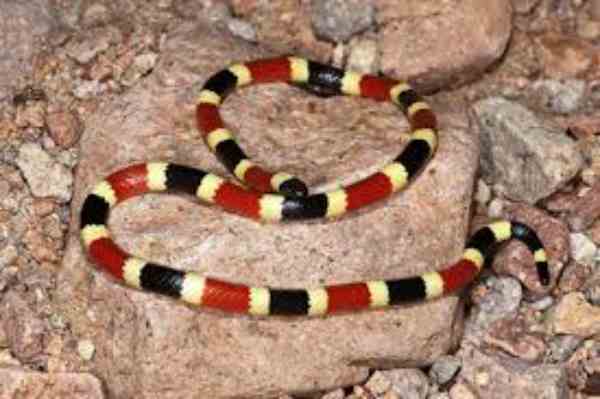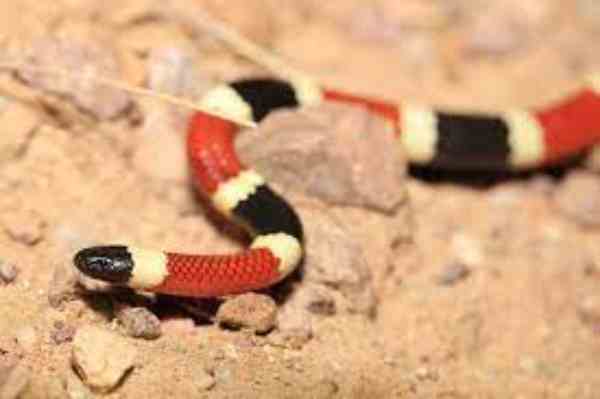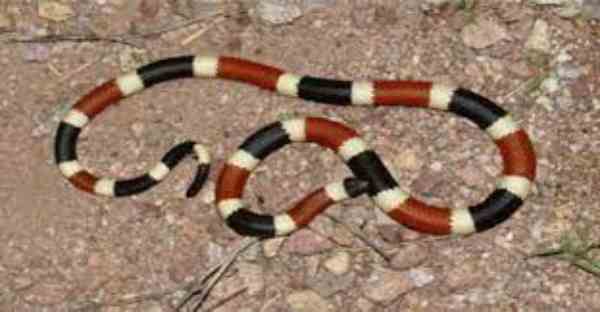The Arizona Coral Snake, also known as Micruroides euryxanthus, is a species of small, venomous snake that can be found in the southwestern United States and northern Mexico. They have a complex but striking pattern of black, red and yellow bands across their bodies. It is important to note that the Arizona coral snake’s colour pattern differentiates it from the similar-looking Nonvenomous Sonoran Whipsnake; however, due to the differences being so subtle, it can often lead to mistaken identification.

Table of Contents
Habitat
The Arizona Coral Snake is most commonly found in the southern portion of Arizona, especially in rocky canyons or grassland terrains. They thrive around hardwood shrubs, mesquite trees, and cactus-covered landscapes. These snakes are nocturnal creatures, spending their days burying themselves under leaf litter or rocks to avoid the hot summer heat and light. During their active nighttime hours, they diligently hunt for small amphibians, lizards, and rodents to prey upon. In colder months when the ground may be icy or frozen over, they can sometimes be found sheltering deeper under vegetative patches or even creating homes within the walls of human abodes.
Colour
Arizona coral snakes, found in the deserts of Arizona and New Mexico, sport an incredibly vibrant pattern across their slender bodies. With deep yellow, crimson, and black bands adorning their shapely forms the snakes stand out brilliantly against the neutral desert sands. Notably, brighter colours typically appear on the head while they tend towards nearly black near the tail.

Diet
The Arizona Coral Snake mainly feeds on small birds, lizards, rodents, and sometimes even other snakes. Some larger coral snakes are also known to occasionally eat a frog or two. To help them digest their prey, the Arizona Coral Snake will periodically consume stones and rocks. The calcium helps break down the proteins of the food faster producing more effective digestion in this species.
Size, Lifespan and Weight
The Arizona coral snake can reach sizes between 20 to 32 inches, making it a sizeable addition to its ecosystem. With an average lifespan of 8-10 years, this is one snake that has staying power but it’s not weighed down by its length; on average it will usually only reach around 3 –4 ounces. While a little light in size when compared to some other species, the beautiful design and hues of the Arizona coral snake make up for what it lacks in weight.

Reproduction
Arizona coral snakes are one of the most fascinating creatures in North America for their highly specialized mating ritual. After the female has found a cosy burrow or crevice to lay her eggs, a male will approach from within feet away and raise himself up high, flaring out his hood while wiggling his tail. This attracts the female and upon contact with her head, he begins an elaborate courtship dance which includes interlocking bodies and further winding movements. Once these rituals have been completed, she then lays a clutch of between 7-11 eggs which are incubated by the heat of the sun’s rays.
Predators
The list of predators for this beautiful creature includes coyotes, badgers, foxes, skunks and birds. These brave creatures will often eat coral snake eggs before they hatch or pre-adult coral snakes if they are lucky enough to catch one. Unfortunately, the fear of the coral snake’s deadly venom means that the animals don’t always have easy access to their food source and have to take extreme precautions when trying to catch a meal.

Arizona coral snake vs kingsnake
Two common reptiles found in Arizona are the coral snake and the kingsnake. Although both snakes have a similar size and share the same habitat, they are very distinct species. The coral snake is an extremely venomous species belonging to the family Elapidae while the kingsnake belongs to another family known as Colubridae, which possesses milder venom.
They differ in appearance as well; the coral snake has bands of red, black and yellow colours while a typical kingsnake has alternating black and white rings. Lastly, corn snakes are largely known to be harmless animals with docile temperaments whereas coral snakes display defensive behaviour when disturbed or aggravated.
Reference:
https://www.desertmuseum.org/books/nhsd_coral_snake.php
https://www.ncwildlife.org/Learning/Species/Reptiles/Eastern-Coral-Snake
https://www.poison.org/articles/coral-snake-bite-treatment-203

Jeevan Kodiyan
An animal enthusiast with an interest in zoology, studying the behavior and activities of animals in the wild habitat. I work on research projects related to species conservation and endangered species protection. I also leverage zoology to become an educator, educating others about the importance of protecting our natural environment and the beauty of animals in their natural habitats.









